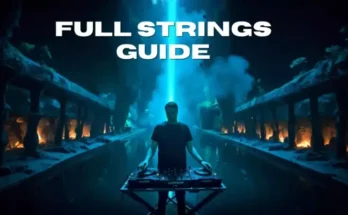Master Flute Playing TUTORiAL
MP4 | Video: h264, 1280×720 | Audio: AAC, 44.1 KHz
Language: English | Size: 1.34 GB | Duration: 5h 0m
Move beyond beginner with MusicProfessor’s intermediate Flute course. A year’s worth of lessons in just a few hours!
What you’ll learn
Play the full, natural range of the flute
Flutter tongue
Interpret when, where, and how to use vibrato
Play for longer periods without fatigue thanks to numerous strength-building exericses
Interpret dynamic markings
Play expressively with phrasing, dynamics, and vibrato
Read complex rhythms and meters like 6/8 and Cut Time
Requirements
Working Flute
Rudimentary knowledge of music theory and notation
Description
COURSE DESCRIPTION
Looking to improve your flute playing? MusicProfessor can help you make the most of your practice. Pick up where MusicProfessor’s Beginner Flute course leaves off, adding more complex rhythms, scales and tone exercises to your repertoire.
And save money while you study with us! Private lessons are expensive. Each MusicProfessor Flute course provides an entire year’s worth of lessons, for a fraction of the cost, and at your own convenience.
Join over 18,000 fellow MusicProfessor students and begin your studies today!
COURSE FEATURES
100+ video lessonsDownloadable sheet musicAnimated fingering chartsFlute equipment recommendationsFlute-specific troubleshooting tips and adviceMultiple warm-up techniquesA guide to flutter tonguingDozens of melodies and songsTechnique-building exercisesMajor scales and scale exercisesProduce and implement vibratoMusic Theory
MusicProfessor’s curriculum is used in nearly 100 schools and school districts throughout the United States and by more than 18,000 students and music teachers throughout the world. Nowhere else can you find the level of detail and professional instruction of MusicProfessor’s curriculum.
Fulfill your musical destiny by enrolling today!
NOTABLE REVIEWS
“Lisa (flute), with her sense of humor, enthusiasm and at the same time, maintaining professionalism, keeps it interesting!”
-nppotdar
“I struggle with going flat the softer I get on higher notes, so I opened up Music Professor and sure enough they had a lesson to help me with my problem. I highly recommend that you use Music Professor if you are having any types of problems on your instrument.”
-E. Doctor
“The intermediate course is really effective, and covers the essentials. The instructor does an exemplary job in presenting the materials, and she is very pleasant and personable. I worked hard, so my results might not represent the norm, but I feel that I am at a lower intermediate level, perhaps ready for the advanced course. Both the beginning and intermediate courses were essentials for me, as I had never held a flute, much less attempted to play one. “
-Bruce Henderson
ABOUT THE INSTRUCTOR
Lisa Garner Santa currently serves as Artist-Performer and Professor of Flute at Texas Tech University where she enjoys a diverse career as teacher, recitalist, soloist, and chamber musician. Performance highlights include the world premiere of Mike Mowers Concerto for Flute and Wind Ensemble and a Carnegie Hall debut recital featuring Chamber Works for Flute.
As an active member of theNational Flute Association, Dr. Garner Santa recently served as Program Chair for the 2011 convention in Charlotte, NC, and continues to serve as a member of the NFA Executive Committee. She has been a featured performer at the Boston, Atlanta, Phoenix, Dallas, Nashville, Kansas City, and Las Vegas conventions as well as an adjudicator and/or coordinator for many NFA events and competitions including the High School Soloist Competition, the NFA Newly Published Music Competition, the NFA Professional Flute Choir Competition, and as the NFA General Competitions Coordinator.
As a pedagogue, Lisa Garner Santa presents masterclasses throughout the United States and abroad. Recent international exchanges include masterclasses at the Royal College of Music in London, England and Victoria University in Wellington, New Zealand. Presentations and performances at various regional and national conventions include invitations from theTexas Music Educators Association, the Texas Music Teachers Association, the National Association of Wind and Percussion Instructors, and theCollege Music Society. Her research and pedagogical articles are frequently published in The Flutist Quarterly, Flute Talk, and The Instrumentalist.
In recognition of her creative teaching, she was awarded the Texas Tech Big 12 Fellowship as well as the Texas Tech Alumni Association New Faculty Award and is also an elected member of Texas Tech University’s prestigious Teaching Academy.
With co-authors Matthew Santa and Thomas Hughes, Lisa Garner Santa developed theFlute/Theory Workout, a method that efficiently introduces full-range scalar and chordal flute technique while introducing music theory fundamentals at the same time. The Workout, which comes with an entertaining accompaniment CD, is available throughCarolyn Nussbaum Music Co., and Flute World.
Dr. Garner Santa holds performance degrees from West Texas State University, Florida State University, and The Shepherd School of Music at Rice University. Her teachers to whom she is eternally grateful include Carol Wincenc, Charles DeLaney, Sally Turk, Helen Blackburn.
In addition to her active role as a flutist, Lisa Garner Santa is also a certified Kripalu Yoga Instructor and member of theYoga Alliance. She teaches Yoga for Musicians at the TTU School of Music and Kripalu Yoga classes at various locations throughout Lubbock.
—
Overview
Section 1: Vibrato
Lecture 1 Introduction
Lecture 2 Recap
Lecture 3 Note Bb
Lecture 4 Exercise 1.1 – Getting to know Bb
Lecture 5 Chromatic Scale
Lecture 6 A-Major Scale
Lecture 7 E-Major Scale
Lecture 8 Exercise 2.1 – Vibrato – Measured A
Lecture 9 Exercise 2.2 – Vibrato – Measured B
Lecture 10 Exercise 2.3 – Vibrato – Unmeasured A
Lecture 11 Exercise 2.4 – Vibrato – Unmeasured B
Lecture 12 Melody 1.1 – Scarborough Fair
Section 2: 16th Notes
Lecture 13 Introduction
Lecture 14 Recap
Lecture 15 Notes Db, C
Lecture 16 Exercise 1.1 – Pinky Madness
Lecture 17 B-Major Scale
Lecture 18 Db-Major Scale
Lecture 19 C-Major Scale, Two Octaves
Lecture 20 Chromatic Scale, Two Octaves
Lecture 21 Exercise 2.1 – 16th Notes
Lecture 22 Exercise 2.2 – Counting 16th Notes
Lecture 23 Melody 1.1 – A Finnish Theme
Lecture 24 Melody 2.1 – A French Theme
Lecture 25 Melody 3.1 – A Texan Theme
Section 3: Major Scale Milestone
Lecture 26 Introduction
Lecture 27 Recap
Lecture 28 Note High Eb
Lecture 29 Exercise 1.1 – Getting to know Eb
Lecture 30 Eb-Major Scale
Lecture 31 Gb-Major Scale
Lecture 32 F#-Major Scale
Lecture 33 Exercise 2.1 – Dotted Eighth + Sixteenth Notes
Lecture 34 Melody 1.1 – Langsam
Lecture 35 Melody 1.2 – Langsam
Lecture 36 Melody 2.1 – John Peel
Lecture 37 Melody 3.1 – Overture to L’arlesienne
Section 4: Accidentals
Lecture 38 Introduction
Lecture 39 Recap
Lecture 40 Notes High E, F
Lecture 41 F-Major Scale
Lecture 42 E-Major Scale
Lecture 43 Chromatic Scale – Two Octaves
Lecture 44 Melody 1.1 – Simple Gifts
Lecture 45 Melody 2.1 – Hallelujah Chorus – Eighth Rests
Lecture 46 Melody 3.1 – March – Sixteenth Rests and Accidentals
Section 5: Syncopation
Lecture 47 Introduction
Lecture 48 Recap
Lecture 49 Notes High F#, G
Lecture 50 Gb, F#-Major Scale
Lecture 51 G-Major Scale
Lecture 52 Melody 1.1 – Yellow Rose – Syncopation
Lecture 53 Melody 2.1 – Joplin Rag
Lecture 54 Melody 3.1 – Minuet
Section 6: Dynamics
Lecture 55 Introduction
Lecture 56 Recap
Lecture 57 Notes High G#, A
Lecture 58 Exercise 1.1 – Getting to know High G# and A
Lecture 59 Ab-Major Scale
Lecture 60 A-Major Scale
Lecture 61 Exercise 2.1 – Dynamics
Lecture 62 Exercise 2.2 – Dynamics
Lecture 63 Melody 1.1 – Theme from Mendohlsson’s 3rd
Lecture 64 Melody 2.1 – Saints
Lecture 65 Melody 3.1 – Simple Gifts
Lecture 66 Melody 4.1 – A Schumann Melody
Lecture 67 Troubleshooting – Playing with Braces
Section 7: Compound Meter
Lecture 68 Introduction
Lecture 69 Recap
Lecture 70 Note High Bb
Lecture 71 Bb-Major Scale
Lecture 72 Intonation
Lecture 73 Exercise 1.1 – Intonation
Lecture 74 Exercise 2.1 – Compound Meter
Lecture 75 Melody 1.1 – Devienne’s Presto
Lecture 76 Melody 2.1 – A French Folk Song
Lecture 77 Melody 3.1 – A German Folk Song
Section 8: Continued Compound Meter
Lecture 78 Introduction
Lecture 79 Recap
Lecture 80 Note High B
Lecture 81 Exercise 1.1 – Getting to know High B
Lecture 82 B-Major Scale, Two Octaves
Lecture 83 Exercise 2.1 – New Rhythms in Compound Meter
Lecture 84 Melody 1.1 – Canadian Folk Song
Lecture 85 Melody 2.1 – Susato Dance
Lecture 86 Exercise 2.2 – More Rhythms in Compound Meter
Lecture 87 Melody 3.1 – The Cold Winter
Lecture 88 Teardrop Embouchure
Section 9: Extended Technique
Lecture 89 Introduction
Lecture 90 Recap
Lecture 91 Note C – 4th Octave
Lecture 92 Exercise 1.1 – Getting to know High C
Lecture 93 C-Major Scale, Three Octaves
Lecture 94 Chromatic Scale – Three Octaves
Lecture 95 Alternate Fingerings for the Third Octave
Lecture 96 Melody 1.1 – Der Freischutz
Lecture 97 Melody 2.1 – Prince Igor
Lecture 98 Melody 3.1 – Entract
Lecture 99 Tone Development with Extended Technique
Section 10: Conclusion
Lecture 100 Final Lesson
Adult Learner,Students looking to catch up,Students looking to get ahead,Music students who can’t access a private teacher,Intermediate Players
Please REPORT in Comment Broken Links




